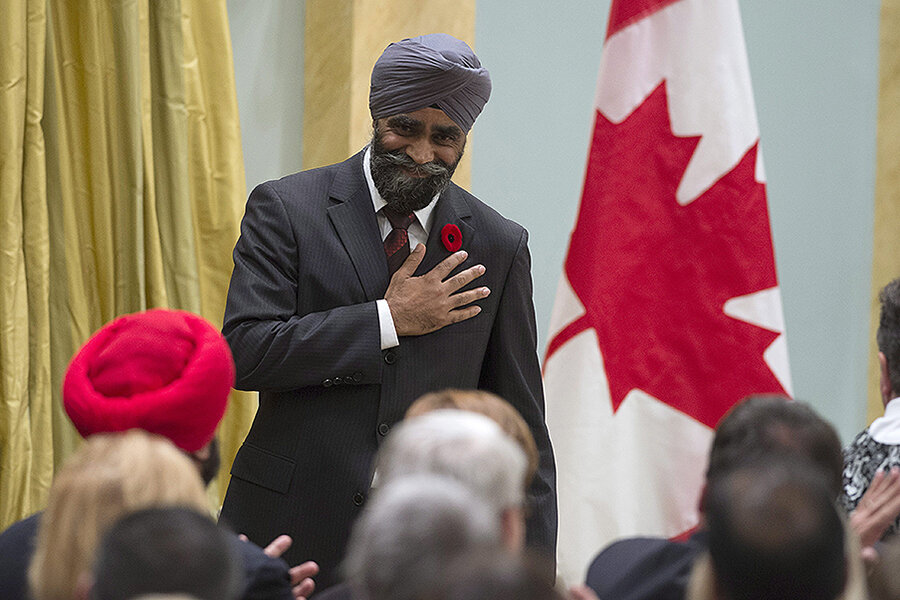Sikh Defense Minister joins Cabinet that 'looks like Canada'
Loading...
When newly-elected Canadian Prime Minister Justin Trudeau's pick for Minister of Defense was sworn in at Ottowa's Rideau Hall on Wednesday, some Canadians may have been surprised to see his appointee.
Harjit Singh Sajjan, a retired reserve lieutenant-colonel and former police officer who served three tours in Afghanistan and another in Bosnia-Herzegovina, was picked over Andrew Leslie, Mr. Trudeau's previous defense advisor.
"Nobody should under-estimate Harjit," his former superior, retired Brigadier-General Dave Fraser, told CTV News. "He is tough and smart, and determined."
But Canada's neighbors to the south may have had a second surprise: Mr. Sajjan's turban, a symbol of his Sikh faith.
In a country that openly debates whether a Muslim should be permitted to be president, it is hard to imagine anyone wearing a turban, regardless of religion, in charge of the nation's armed forces – particularly because US military regulations on soldiers' personal grooming have made it nearly impossible for Sikhs to serve while upholding their faith.
Sikhism, the world's fifth-largest religion, is a monotheistic religion founded in India more than 500 years ago, emphasizing equality and service as paths to draw closer to God; at the Golden Temple of Amritsar, India, thousands of volunteers prepare communal meals for the 80,000 visitors who show up each day. Sikhism holds that, to show their devotion to God's creation, Sikh men should not cut their hair, which is wound into a turban each day.
It's a look that makes them conspicuous in North America, where hundreds of Sikhs have been the victims of hate crimes, particularly when attackers confuse them with Muslims. In August 2012, a massacre at a Wisconsin temple made headlines when a white supremacist shot six Sikh worshippers. But such attacks were not new: the first victim of an allegedly Islamophobic hate crime after September 11, 2001 was a Sikh gas-station owner in Arizona. In 2012, the Sikh Coalition of Washington reported that there had been 700 attacks over the past decade.
"What a dynamite story," Canada's CTV political analyst Scott Reid said of Sajjan:
20 years ago, we were debating whether or not people with turbans could serve in the military. Today, the military will be led by a man with a turban. A man who is a decorated soldier, a former police officer; no one can quarrel with his credentials.
But that debate is ongoing in the United States, where soldiers today are slowly opening the door for future Sikhs to serve their country. Sikhism has a longstanding tradition of "saint-soldiers" who preach "you can't have peace without justice," in the words of US Army Major Kamaljeet Kalsi, who spoke with NPR in 2013 about Sikh soldiers' battle to have their turbans and beards accepted in the military – from which, they predict, societal acceptance will follow.
From 1948 to 1984, Sikhs were free to serve without compromising their articles of faith, but then new regulations against religious garb were put in place.
"The Jewish lobby was able to appeal the [yarmulke] ruling, and the Sikhs, well, we really had no voice. We had no lobby," Major Kalsi, a medical director at Fort Bragg, told NPR.
"I was told there were two challenges to allow Sikhs in the military. The first was that we could not put the Kevlar helmet on our heads, which I do every day," Captain Tejdeep Singh Rattan told Army writer Steve Elliot. "The second thing was fitting the gas mask properly," which proved not to be a problem.
In 2010, Rattan and Kalsi were the first Sikh soldiers in nearly three decades permitted to keep their turbans and beards, after 49 members of Congress petitioned Defense Secretary Robert Gates on their behalf. The Army says it will consider future requests on a case-by-case basis.
"Our country was built by people like me, from different parts of the world, from different races and religions.... I am willing to lay down my life for America. I ask only that my country respect my faith, an integral part of who I am. My turban and beard are not an option, they are an intrinsic part of me," Rattan argued.
In Canada, Sajjan will join a cabinet that "looks like Canada," according to Trudeau, who told reporters that he had filled half of his advisers' seats with women, "Because it's 2015."
"We beat fear with hope," he said, congratulating supporters during his victory speech, after a campaign in which rival incumbent Stephen Harper's Conservative Party was criticized for focusing on Muslim and immigration issues, which critics alleged were less pressing than a number of problems, such as Canada's own First Nations' problems.
But even with a diverse Cabinet, a national pat on the back may be premature, Toronto journalist Desmond Cole argued in an opinion column for the Star:
If fear was something Conservatives had dreamed up in a strategy meeting, and not an embedded Canadian challenge, I might agree [that we 'beat fear']. This campaign has revealed how much work we have ahead, and why we must commit to anti-racism in Canada.








